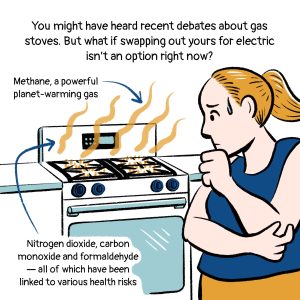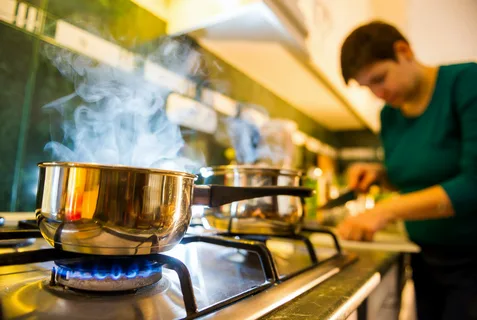Introduction Gas stoves have become an indispensable part of modern kitchens, offering convenience and efficiency in cooking. However, what often goes unnoticed is the pollution they can generate. The combustion of gas releases various pollutants into the air, contributing to indoor air pollution and posing significant health risks. In this article, we’ll delve into the
Introduction
Gas stoves have become an indispensable part of modern kitchens, offering convenience and efficiency in cooking. However, what often goes unnoticed is the pollution they can generate. The combustion of gas releases various pollutants into the air, contributing to indoor air pollution and posing significant health risks. In this article, we’ll delve into the impact of gas stove pollution and explore effective strategies to mitigate it, ensuring cleaner air in our homes.
Gas Stove Pollution
Gas stoves utilize natural gas or propane for cooking, emitting pollutants such as carbon monoxide, nitrogen dioxide, and formaldehyde during combustion. Despite their efficiency, these emissions can have detrimental effects on both health and the environment. Carbon monoxide, for instance, can hinder the body’s oxygen transport mechanism, leading to symptoms like headaches, dizziness, and fatigue. Nitrogen dioxide irritates the respiratory system and worsens conditions like asthma. Additionally, gas stove emissions contribute to outdoor air pollution, further exacerbating environmental issues.
Understanding the Impact
Health Risks
The health risks associated with gas stove pollution are profound. Exposure to carbon monoxide and nitrogen dioxide can lead to respiratory problems, cardiovascular issues, and even neurological damage. Vulnerable populations such as children, the elderly, and individuals with pre-existing health conditions are particularly susceptible to the adverse effects of these pollutants.

Image by: yendex.com
Environmental Damage
In addition to posing risks to human health, gas stove pollution contributes to environmental degradation. Emissions from gas combustion contribute to smog formation, acid rain, and greenhouse gas emissions, exacerbating climate change and harming ecosystems.
Simple Ways to Reduce Gas Stove Pollution
Proper Ventilation
Ensuring adequate ventilation in the kitchen is paramount to reducing gas stove pollution. Installing and using a range hood or exhaust fan helps remove pollutants from the air, preventing their accumulation indoors. Opening windows and doors during cooking also facilitates air exchange, further improving indoor air quality.
Regular Maintenance
Regular maintenance of gas stoves is essential for optimal performance and emission reduction. Cleaning burners, inspecting gas lines for leaks, and ensuring proper flame adjustment are crucial steps in maintaining a clean and efficient gas stove.
Use of Efficient Cookware
Using high-quality cookware can minimize gas consumption and reduce emissions from gas stoves. Opt for flat-bottomed pots and pans with tight-fitting lids, as they facilitate efficient heat transfer and minimize heat loss, thereby decreasing cooking time and gas usage.
Alternative Cooking Methods
Exploring alternative cooking methods can help reduce reliance on gas stoves and lower overall emissions. Steaming, boiling, and using slow cookers are excellent alternatives that consume less energy and produce fewer pollutants. Additionally, outdoor grilling or solar cooking can be viable options for reducing indoor air pollution.

Image by: yendex.com
Investing in Electric or Induction Stoves
Consider transitioning to electric or induction stoves, which produce fewer emissions compared to gas stoves. While the initial investment may be higher, the long-term benefits for both health and the environment are substantial. Electric and induction stoves offer precise temperature control, faster cooking times, and reduced environmental impact, making them a cleaner alternative to traditional gas stoves. Explore More About (Monkeypox Solution)
Importance of Regular Cleaning
Regular cleaning of gas stove components, such as burners, grates, and drip pans, is essential for maintaining optimal performance and reducing emissions. Built-up grease and debris can impede proper combustion, leading to increased emissions and decreased efficiency. Cleaning these components regularly not only improves air quality but also prolongs the lifespan of the stove and ensures safe operation.
Choosing Cleaner Fuel Options
Opting for cleaner fuel options can significantly reduce emissions from gas stoves. Natural gas with lower sulfur content or renewable biogas are cleaner alternatives that produce fewer pollutants. Consult with local utilities or suppliers to explore cleaner fuel options available in your area and make the switch to a more sustainable fuel source.
Educating Others
Spreading awareness about the impact of gas stove pollution and sharing tips for reducing emissions is crucial for promoting cleaner cooking practices. Whether through social media, community workshops, or conversations with friends and family, education plays a vital role in fostering behavior change and encouraging others to adopt environmentally friendly cooking habits.
| Factor | Gas Stoves | Electric Cooktops | Induction Cooktops |
|---|---|---|---|
| Emissions | Emit pollutants like CO and NO2 | Produce no emissions | Produce no emissions |
| Energy Efficiency | Moderate | Moderate | High |
| Temperature Control | Good | Good | Excellent |
| Cooking Speed | Fast | Moderate | Fast |
| Heat Distribution | Uneven | Even | Even |
| Safety | Risk of gas leaks, open flame | No risk of gas leaks, no open flame | No risk of gas leaks, no open flame |
| Installation | Requires gas line | Requires electrical connection | Requires electrical connection |
| Maintenance | Regular cleaning and inspection | Easy to clean, no special maintenance | Easy to clean, no special maintenance |
| Environmental Impact | Contributes to indoor air pollution | Minimal impact | Minimal impact |
| Cost | Moderate | Moderate | High |
Conclusion
In conclusion, addressing gas stove pollution is imperative for safeguarding both human health and the environment. By implementing simple yet effective strategies such as proper ventilation, regular maintenance, and exploring alternative cooking methods, we can minimize emissions and ensure cleaner air in our homes. Additionally, transitioning to cleaner fuel options and educating others about the importance of reducing gas stove pollution can collectively contribute to a healthier and more sustainable future.
















